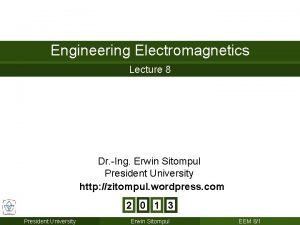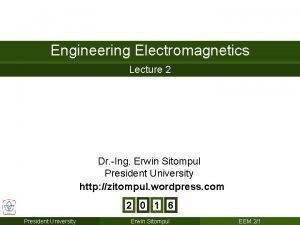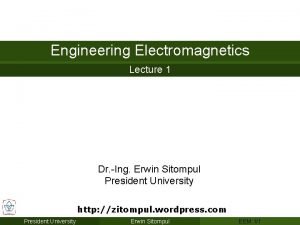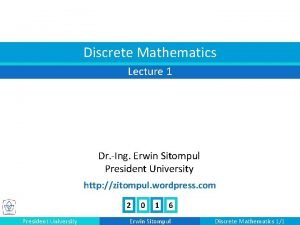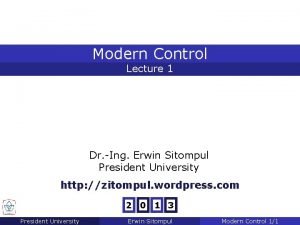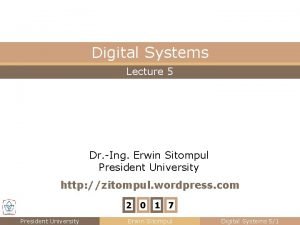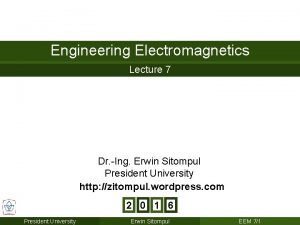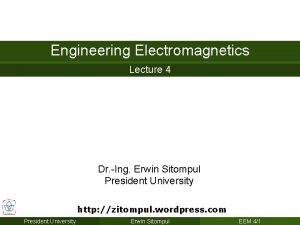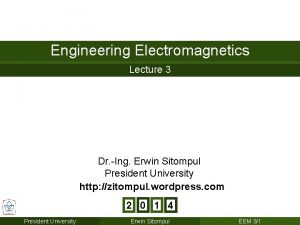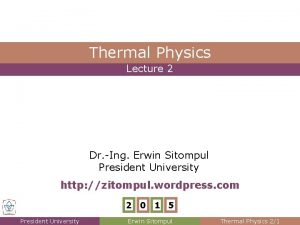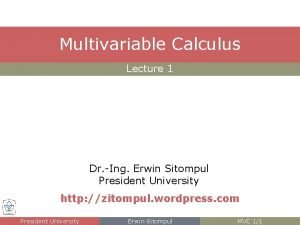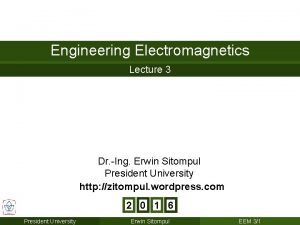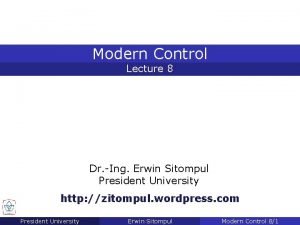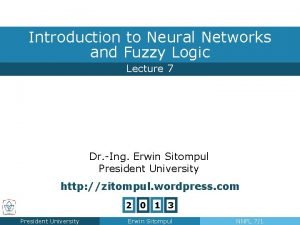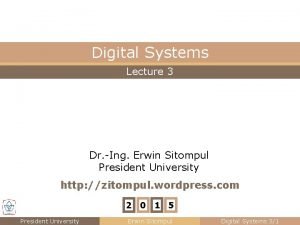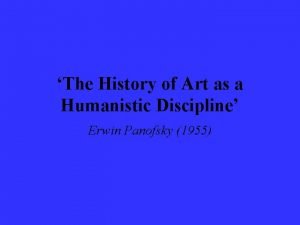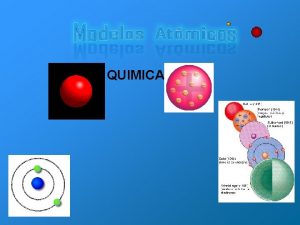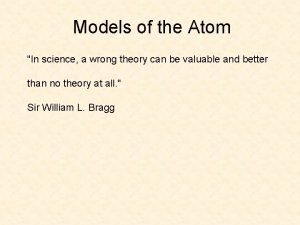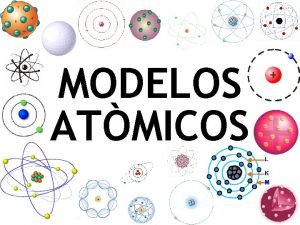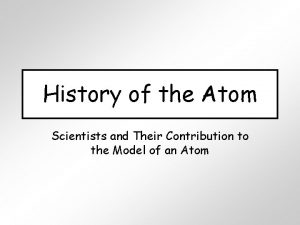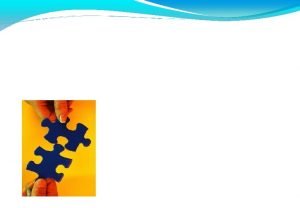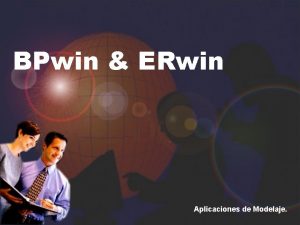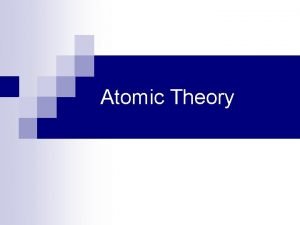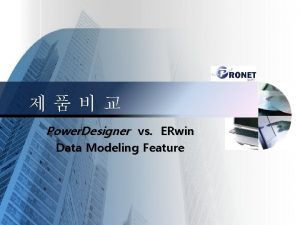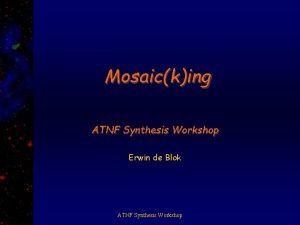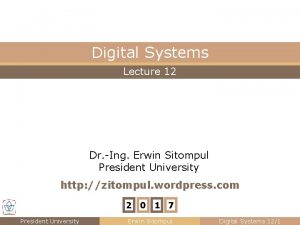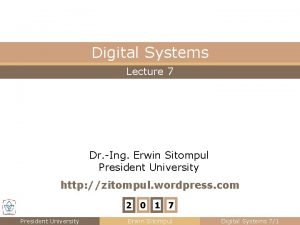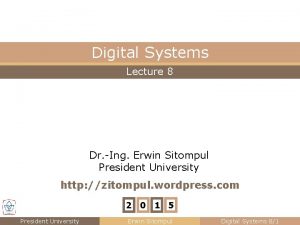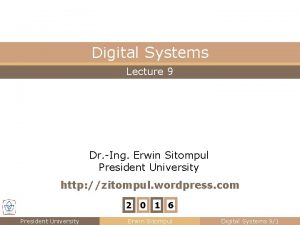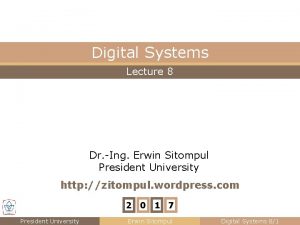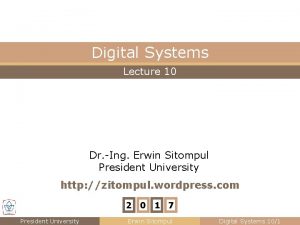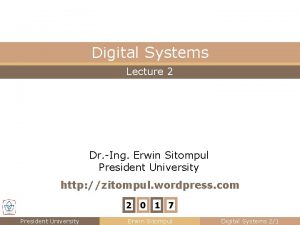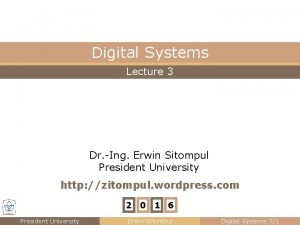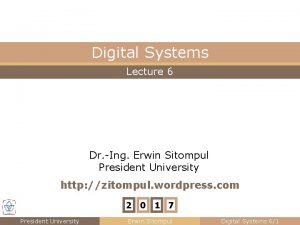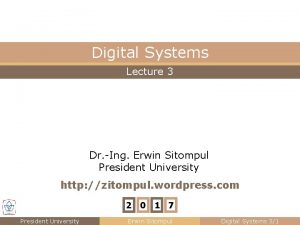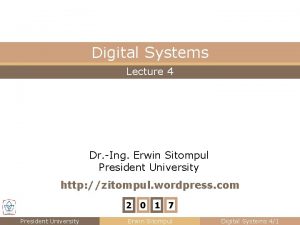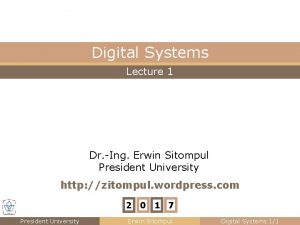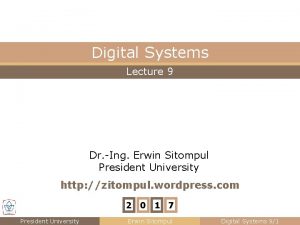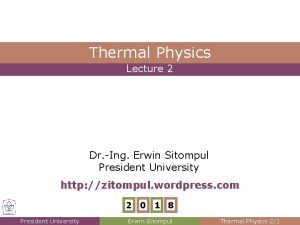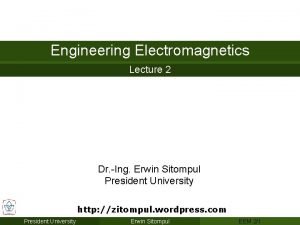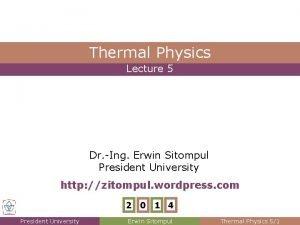Digital Systems Lecture 1 Dr Ing Erwin Sitompul




























- Slides: 28

Digital Systems Lecture 1 Dr. -Ing. Erwin Sitompul President University http: //zitompul. wordpress. com 2 0 1 5 President University Erwin Sitompul Digital Systems 1/1

Digital Systems Textbook and Syllabus Textbook: “Fundamentals of Digital Logic with VHDL Design”, Brown and Vranesic, Mc. Graw-Hill, 3 rd Edition, 2009. Topics: Introduction Number Systems Logic Gates and Boolean Algebra Gate-level Minimization Combinatorial Logic Sequential Logic (Latches, Flip-Flops, Registers, and Counters) § Memory and Programmable Logic § Hardware Descriptian Language (Verilog and VHDL) § § § President University Erwin Sitompul Digital Systems 1/2

Digital Systems Grade Policy Final Grade = 10% Homework + 20% Quizzes + 30% Midterm Exam + 40% Final Exam + Extra Points n Homeworks will be given in fairly regular basis. The average of homework grades contributes 10% of final grade. n Written homeworks are to be submitted on A 4 papers, otherwise they will not be graded. n Homeworks must be submitted on time, one day before the next lecture. Late submission will be penalized by point deduction of – 10·n, where n is the total number of lateness made. n There will be 3 quizzes. Only the best 2 will be counted. The average of quiz grades contributes 20% of final grade. n The maximum lateness in coming to class is 25 minutes, otherwise attendance will not be counted. President University Erwin Sitompul Digital Systems 1/3

Digital Systems Grade Policy n Midterm and final exams follow the schedule released by AAB (Academic Administration Bureau). n Make up of quizzes must be requested within one week after the schedule of the respective quiz. n Make up for mid exam and final exam must be requested directly to AAB. Thermal Physics Homework 2 Emelie Raturandang 0029202400058 21 March 2027 No. 1. Answer: . . . . ● Heading of Written Homework Papers (Required) President University Erwin Sitompul Digital Systems 1/4

Digital Systems Grade Policy n In order to maintain the integrity, the maximum score of a make up quiz or exam, upon discretion, can be set to 90. n Extra points will be given if you solve a problem in front of the class. You will earn 1 or 2. n Lecture slides can be copied during class session. It is also available on internet. Please check the course homepage regularly. http: //zitompul. wordpress. com n The use of internet for any purpose during class sessions is strictly forbidden. President University Erwin Sitompul Digital Systems 1/5

Digital Systems Section 1 Introduction President University Erwin Sitompul Digital Systems 1/6

Lecture Digital Systems The Evolution of Computer Hardware n Modern-day electronics began with the invention of the transfer resistor (transistor) in 1947. n By John Bardeen, Walter Brattain, and William Shockley at Bell Laboratories. n A transistor is a semiconductor device used to amplify and switch electronic signals and electronic power. President University Erwin Sitompul Digital Systems 1/7

Lecture Digital Systems The Evolution of Computer Hardware n In digital circuits, transistors are arranged to function as logical switch. n Logical switch has only 2 values: 1 (on/high) and 0 (of/low). n In general, a switch has three parts: source input, control input, and output. n The control input is represented by a voltage that will decide whether current can flow through the switch or not. control input “off” source input output control input source input “on” output n As the size of transistor shrinks, the size of electronic devises also shrinks. relay President University Erwin Sitompul vacuum discrete integrated tube transistor circuit Digital Systems 1/8

Lecture Digital Systems The Evolution of Computer Hardware n In 1958 the first integrated-circuit (IC) was born when Jack Kilby at Texas Instruments successfully interconnected, by hand, several transistors, resistors and capacitors on a single substrate. n Interconnection between components are not integrated. n Low connectivity between components. President University Erwin Sitompul Digital Systems 1/9

Lecture Digital Systems The Evolution of Computer Hardware n In 1999, Power. PC 750 L was introduced. n In contains 3. 65 millions of transistors, with die size of 40 mm 2. n The clock rate is 300– 533 MHz, with power consumption of 6 W at 500 MHz. n As in 2015, i 7 cores work in 2. 673. 33 GHz, with multiple cores. President University Erwin Sitompul Digital Systems 1/10

Lecture Digital Systems The Evolution of Computer Hardware n Advances in technology increase the performance of computer hardware and decrease the production cost enormously. Year Technology 1951 Vacuum Tube 1965 Transistor 1975 Integrated Circuit (IC) 1995 Very Large Scale IC (VLSI) 2005 Ultra VLSI President University Relative Performance/ Unit Cost 1 35 900 2, 400, 000 6, 200, 000 Erwin Sitompul Digital Systems 1/11

Lecture Digital Systems The Evolution of Computer Hardware Application Compiler Software Hardware Operating System Assembler Processor | Memory | I/O System Data path and Control Digital Design Circuit Design Transistors n The scope of this lecture is theory and implementation of digital design, in the hardware layer. President University Erwin Sitompul Digital Systems 1/12

Digital Systems Section 2 Number Systems President University Erwin Sitompul Digital Systems 1/13

Lecture Digital Systems Overview of Number Systems n Decimal: 0, 1, 2, 3, . . . , 8, 9, 10, 11, . . . , 123, 456, . . . n Binary: 0, 1, 10, 11, 100, 101, . . . n Unary: 1, 111, 11111, . . . n Duodecimal (base 12) n Hexadecimal (base 16): 0, 9, 31, 2 F, C 32 A n Sexagesimal (base 60): 2: 30: 55, 6° 12’ 36” ? President University ● Convert C 32 A to decimal, to binary. Erwin Sitompul Digital Systems 1/14

Lecture Digital Systems Decimal Numbers n Decimal numbers are made of decimal digits (0, 1, 2, 3, 4, 5, 6, 7, 8, 9). n Number representation: 8653 = 8· 103 + 6· 102 + 5· 101 + 3· 100 n Formal notation for this number is (8653)10. n Fraction representation: 97654. 35 = 9· 104 + 7· 103 + 6· 102 + 5· 101 + 4· 100 + 3· 10– 1 + 5· 10– 2 n Formal notation: (97654. 35)10. President University Erwin Sitompul Digital Systems 1/15

Lecture Digital Systems Binary Numbers n Binary numbers are made of binary digits or bits (0, 1). n Number representation: (1011)2 = 1· 23 + 0· 22 + 1· 21 + 1· 20 = (11)10. n Fraction representation: (100. 10)2 = 1· 22 + 0· 21 + 0· 20 + 1· 2– 1 + 0· 2– 2 = (4. 5)10. n A group of eight bits are called a byte. n For example, (11001001)2. President University Erwin Sitompul Digital Systems 1/16

Lecture Digital Systems Octal and Hexadecimal Numbers n Octal numbers are made of eight distinct symbols (0, 1, 2, 3, 4, 5, 6, 7). n Number representation: (217)8 = 2· 82 + 1· 81 + 7· 80 = (143)10. n Hexadecimal numbers are made of sixteen distinct symbols (0, 1, 2, 3, 4, 5, 6, 7, 8, 9, A, B, C, D, E, F). n Number representation: (2 AF 3)16 = 2· 163 + 10· 162 + 15· 161 + 3· 160 = (10995)10. n Each hexadecimal digit represents four bits. President University Erwin Sitompul Digital Systems 1/17

Lecture Digital Systems Conversion between Number Bases Octal (base 8) Decimal (base 10) Binary (base 2) Hexadecimal (base 16) President University Erwin Sitompul Digital Systems 1/18

Lecture Digital Systems Converting Integer Decimal to Binary 1. 2. 3. 4. 5. Divide the decimal number by the base (2, 8, or 16). The remainder is the lowest-order digit. Divide the result from Step 2 by the base again. The remainder is the next higher-order digit. Repeat Step 3 and Step 4 until the result is zero. Decimal Result Remainder 13/2 6 1 = a 0 6/2 3 0 = a 1 3/2 1 1 = a 2 1/2 0 1 = a 3 (13)10 = (a 3 a 2 a 1 a 0)2 = (1101)2 President University Erwin Sitompul Digital Systems 1/19

Lecture Digital Systems Exercise Convert 18932 to binary and hexadecimal numbers. A ● (18932)10 = (100100111110100)2 ● (18932)10 = (49 F 4)16 President University Erwin Sitompul Digital Systems 1/20

Lecture Digital Systems Digital Computer System n Digital systems consider discrete amounts of data. For example, consisting characters built by 26 letters in the alphabet and 10 decimal digits. n Larger quantities can be constructed from these discrete values: word is made of letter, sentence is made of words, and so on. Numbers are made of more and more digits. n Computers operate on binary value (0 and 1). n It is easy to represent binary values electrically, through voltage or current. n We can assign: high = 1, low = 0; on = 1, off = 0. n The logical operations can be implemented using circuits, which are the building blocks of modern computers. President University Erwin Sitompul Digital Systems 1/21

Lecture Digital Systems Why is Binary Number Used? n It is easy to represent 0 and 1 using electrical values (voltages or currents). n It is possible to tolerate noise (by assigning a certain range for each signal). n It is easy to transmit the data President University Erwin Sitompul Digital Systems 1/22

Lecture Digital Systems The Growth of Binary Numbers n 2 n 0 20 =1 11 2048 1 21 =2 12 4096 2 22 =4 20 1. 04 M 3 8 30 1. 07 G 4 16 40 1. 1 T 5 32 50 1. 1 P 6 64 7 128 8 256 9 512 10 1024 President University Erwin Sitompul Digital Systems 1/23

Lecture Digital Systems Binary Data Storage and Representation n Binary cells store individual bits of data. n Multiple cells form a register. n Data in registers can indicate different values, such as: n Hexadecimals n Binary-Coded Decimal (BCD) n ASCII (American Standard Code for Information Interchange) ● A binary cell ● The data above can be interpreted as 4 F (hexadecimal) 4 15 (for BCD) Letter O (for ASCII) President University Erwin Sitompul Digital Systems 1/24

Lecture Digital Systems Binary-Coded Decimal (BCD) n Binary coded decimal (BCD) represents each decimal digit with four bits. n For example, 32910 = 0011 0010 1001 3 2 9 n But, 32910 = 1010010012 Digit BCD Code 0 0000 5 0101 1 0001 6 0110 2 0010 7 0111 3 0011 8 1000 4 0100 9 1001 n BCD is not efficient, commonly used in early computers. n It is still in some applications, such as to encode numbers for sevensegment (by using a BCD to 7 Segment Decoder). ? President University ● A BCD clock ● What time is it? Erwin Sitompul Digital Systems 1/25

Lecture Digital Systems Register Transfer n Data can be moved from register to register, for a certain meaning or purpose. n Digital logic is used to process the data. The overall system is called a digital system. n We will learn about digital logic and how it is used to design a digital system. Register A Register B Digital Logic Circuits Register C President University Erwin Sitompul Digital Systems 1/26

Lecture Digital Systems n In any problem design and analysis, we need to determine the binary outputs for each combination of inputs. n For a given task, we must develop a circuit that accomplishes the task. n Many ways of implementations are thus possible. n We should try to develop the “best” circuit based on some criterion (size, power consumption, performance, price, etc. ) Inputs President University . . . Logic Circuit . . . Erwin Sitompul Outputs Digital Systems 1/27

Lecture First Law of Thermodynamics Homework 1 1. Convert (9522)10 to binary and to hexadecimal. 2. Convert (369. 6875) to binary and to octal. 3. Convert (3 F 67 A)16 to decimal and to binary. 4. One grain of rice is put on the first square of a chessboard, two on the second, four on the third, and so on (the number of grain is doubled from one square to the next). (a) How many grain of rice would be on the last square? ; (b) Assuming that one grain weigh 20 mg, determine the weight of the rice on that last square. n Deadline: Wednesday 16 September 2015. President University Erwin Sitompul Digital Systems 1/28
 Erwin sitompul
Erwin sitompul Erwin sitompul
Erwin sitompul Erwin sitompul
Erwin sitompul Logic sitompul
Logic sitompul Erwin sitompul
Erwin sitompul Digital systems
Digital systems Erwin sitompul
Erwin sitompul Erwin sitompul
Erwin sitompul Erwin sitompul
Erwin sitompul Erwin sitompul
Erwin sitompul Projvu
Projvu Erwin sitompul
Erwin sitompul Erwin sitompul
Erwin sitompul 01:640:244 lecture notes - lecture 15: plat, idah, farad
01:640:244 lecture notes - lecture 15: plat, idah, farad Logic sitompul
Logic sitompul Logic sitompul
Logic sitompul Operating system lecture notes
Operating system lecture notes Lecture sound systems
Lecture sound systems Lecture sound systems
Lecture sound systems The history of art as a humanistic discipline
The history of art as a humanistic discipline Modelo de dalton mg
Modelo de dalton mg Schrodinger atom model
Schrodinger atom model Atomo de niels bohr
Atomo de niels bohr Erwin schrödinger atomic theory
Erwin schrödinger atomic theory Erwin moeyaert
Erwin moeyaert Bpwin
Bpwin Neils bohr
Neils bohr Powerdesigner vs erwin
Powerdesigner vs erwin Erwin de blok
Erwin de blok
